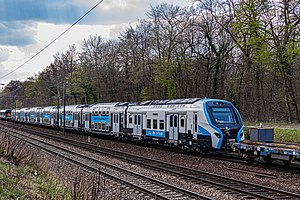Rail transport in Cartadania
This article is a work-in-progress because it is incomplete and pending further input from an author. Note: The contents of this article are not considered canonical and may be inaccurate. Please comment on this article's talk page to share your input, comments and questions. |
| Rail network of Cartadania | |
|---|---|
 | |
| Operation | |
| National railway | Orenvia |
| Infrastructure company | Orenvia Complexo |
| Major operators | Orenvia (ORN) Lealia (LEA) Bay Western Lines (BWL) Northstar (NST) |
| System length | |
| Total | 482,645 km (299,902 mi) |
| Electrified | 98% |
| High-speed | 16,250 kilometers (10,100 mi) |
| Track gauge | |
| Main | 1,435 mm / 4 ft 8+1⁄2 in standard gauge |
| Electrification | |
| Main | 25 kV 60 Hz |
| Total length | 472,991 km (293,903 mi) |
| Features | |
| No. tunnels | 118 |
| Tunnel length | 112.6 km (70.0 mi) |
| Longest tunnel | Carina Bay Bridge Tunnel 5 km (3.1 mi) |
| No. bridges | 1,795 |
| Longest bridge | Marée Channel Bridge-Tunnel 66.1 km (41.1 mi) |
| No. stations | 3,296 |
| Highest elevation | Mariangate Station 1,891.3 m (6,205 ft) |
| Lowest elevation | Añaquín Valley −82.6 m (−271 ft) |
Rail transport in Cartadania serves as a principal means of transportation, particularly for mass and high-speed travel between major cities and commuter transport within urban areas. The country’s railway network is distinguished by its extensive coverage, efficient coordination, integration with other modes of transport, and high level of service reliability. These attributes contribute to a robust domestic and trans-Sarpedonian passenger and freight system, despite the nation’s vast size. The effectiveness of this system is largely driven by stringent regulations on surface transport and well-coordinated intermodal logistics, which facilitate the seamless movement of goods and passengers nationwide.
Cartadania’s railway network, with a length of 480,000 kilometers (300,000 mi), is among the densest in Sarpedon. The country leads in kilometers traveled per inhabitant annually, averaging 162,285 kilometers (100,839 mi) per person as of 2028. This high level of rail travel not only ensures efficient transportation but also reduces the burden on the nation’s roadway infrastructure by decreasing the number of vehicles, particularly heavy trucks, on various parts of the network.
A prominent feature of Cartadania’s railway system is its widespread electrification, with nearly 100% of the tracks powered by electricity. The few remaining sections that still utilize non-electric locomotives are generally reserved for tourism and other special purposes. Additionally, the country has a diverse array of railway companies, with 31 operators creating a competitive and dynamic environment for rail transportation. Public transport, including railways, plays a critical role in Cartadania’s commuter landscape, with approximately 40% of commuters relying on public transport as their primary mode of travel to work. This widespread reliance on rail for daily commuting has emphasized the significance of railways as a reliable and convenient transportation option for the workforce.
In terms of goods transportation, rail holds a substantial share of Cartadania’s modal split, with 44% of goods transport performance by road and rail. This has emphasized the importance of railways as a preferred mode for transporting goods across the country, further contributing to the efficient movement of goods and fostering economic development.